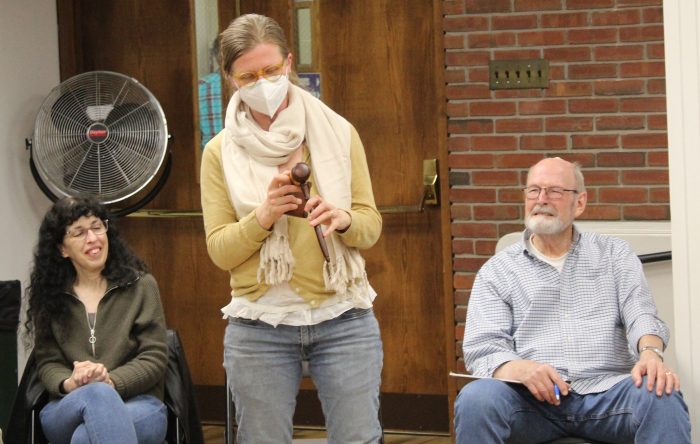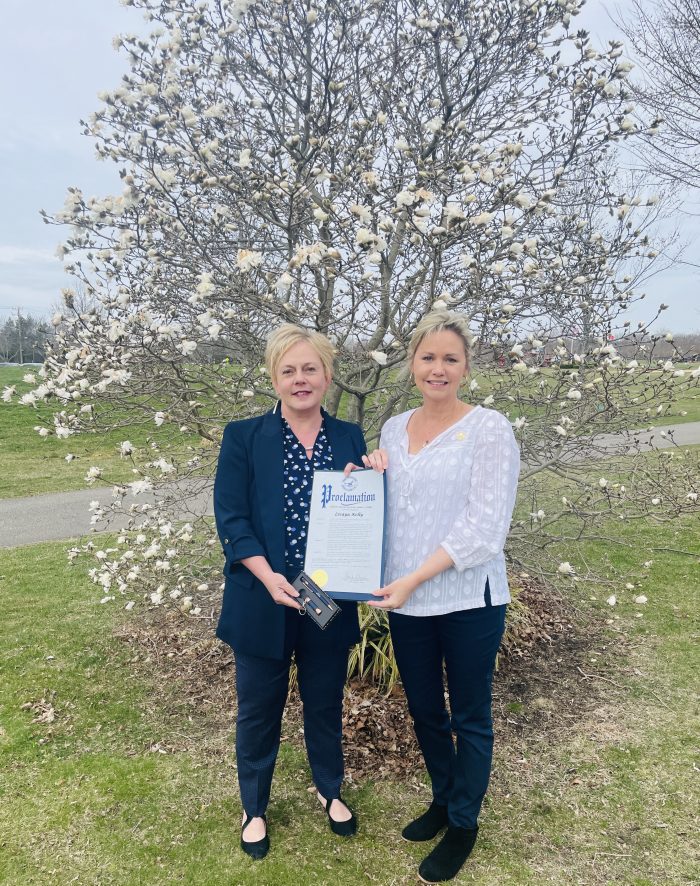Brookhaven boat ramp reconfiguration to settle longtime safety concerns

On a rainy evening in April 2017, Smithtown resident Joe Cristino drove north on Barnum Avenue in Port Jefferson when he approached the intersection of West Broadway.
Between poor visibility and unfamiliarity with the sideroads, Cristino continued straight as the light turned green. This decision would prove to be nearly fatal.
Within seconds, Cristino’s vehicle was in the Port Jefferson Harbor, having plunged off the Brookhaven Town boat ramp just west of the marina. Six years later, he and two indivduals who helped save his life met with Town of Brookhaven Councilmember Jonathan Kornriech (D-Stony Brook) at the scene to discuss potential progress.
Cristino recalled the moment he drove off the dock. “I see that I’m in the water, so I screamed out, ‘Help, please help,’ and I saw two people at the dock, and they came running into the water,” he remembered. “Next thing I know, I’m in the hospital.”
Cristino lost consciousness for hours, placed in a medically induced coma. Doctors did not know if he would be brain dead. He remained hospitalized for five days following the incident.
Luckily for him, there were two good Samaritans — Scott Declue and Neil DeVine — who helped to pull him from the water, saving his life.
Declue, who had braved the 38-degree water to pull Cristino from the car, remembered the trauma of looking into the eyes of a seemingly dying man.
“It’s something you never forget,” he said. “All I remember was looking at him and seeing those eyes, like, ‘You’re my only hope.’”
Declue recalled Cristino’s precarious physical condition: “He was foaming at the mouth, and when they pulled him out, he was in a [near] rigor mortis form, frozen.”
DeVine had jumped into the water as well. Along with Tony Barton and Wayne Rampone Jr., DeVine helped to pull a life-rescue line and ring carrying Cristino and Declue, lifting them from the frigid water.
DeVine, a Port Jefferson resident, remarked upon the severity of the moment. “To fail at this attempt would have changed our lives dramatically,” he said.
Cristino, Declue and DeVine remain friends, united by shared trauma.

Layout changes
In December, Nassau resident Stuart Dorfman was pronounced dead at the scene after driving off the same dock. [See story, “Man suffers medical emergency, drives off dock in Port Jefferson,” TBR News Media website.] Six years after the original incident, the boat ramp remains the same.
DeVine, who passes by the intersection frequently, described an unnerving feeling of hearing about another tragedy. “Reading that in the paper definitely stirred up some feelings there,” he said.
The Town of Brookhaven is taking tangible steps toward remediating the issue. Kornreich, whose 1st Council District includes Port Jefferson, attended the dock reunion with Cristino, Declue and DeVine.‘This hopefully will never happen again.’
— Jonathan Kornreich
Kornreich noted that the dock issue first came to his attention after reading about the most recent fatality at the site, after which he approached the town parks commissioner, Edward Morris, asking for a redesign. The commissioner complied with the request.
“There have been a number of these kinds of incidents,” the councilmember said. “We’re getting ready to repave over here, so as part of that I asked the parks commissioner, and we’ve redesigned” the intersection.
Kornreich presented engineering plans for the redesign, which include closing off much of the existing exit to traffic while adding trees and additional signage. The councilmember said the proposed layout changes should go into effect in the coming months.
Resolutions
Upon hearing the story of Cristino’s near-death experience, Kornreich expressed both consolation for the victim and optimism for the site’s future.
“This hopefully will never happen again,” he said to Cristino. “What you went through, no one should have to endure.”
Assessing the engineering plans, Declue remarked, “This is amazing compared to what’s going on here now.”
On why the safety hazard has stood unchanged for so many years, Kornreich suggested that simple solutions require the necessary public attention and political initiative. “It’s not politics, it’s not complicated,” the councilmember said. “It’s just that someone has to say, ‘Hey, there’s a problem here, and let’s fix it.’”‘The only regret is that it didn’t happen sooner.’
— Neil DeVine
DeVine conveyed his confidence in the new plan. “The only regret is that it didn’t happen sooner,” he said. “But I’m happy that things are going to get done now, and I’m so thankful that Joe is here with us today.”
Declue noted that tragic events do not always come to tidy resolutions. He thanked Kornreich and the town for recognizing the public’s concern and putting a plan in place.
“You don’t have good outcomes like this all the time,” he said.
As for Cristino, who opted not to sue the town for the injuries he sustained, he remained appreciative of the potential remedy, though reminding the town not to let up until the intersection is made safe for all.
“Let’s try to get the ball rolling so that no one else will have to suffer a horrible event as I had,” he said.

















































